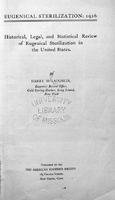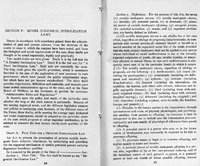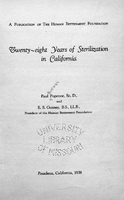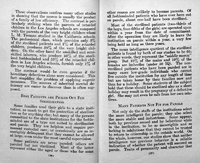Controlling Heredity
Eugenics and Sterilization

Harry Hamilton Laughlin (American, 1880 – 1943)
Eugenical Sterilization: 1926; Historical, Legal and Statistical Review of Eugenical Sterilization in the United States.
New Haven: The American Eugenics Society, 1926.
Depository 613.94 L368e
University of Missouri Libraries
University of Missouri

Harry Hamilton Laughlin (American, 1880 – 1943)
Eugenical Sterilization: 1926; Historical, Legal and Statistical Review of Eugenical Sterilization in the United States.
New Haven: The American Eugenics Society, 1926.
Depository 613.94 L368e
University of Missouri Libraries
University of Missouri
Harry Laughlin was a tireless promoter of eugenic sterilization laws and served as a consultant to many states legislatures. By 1914, twelve states had already passed sterilization laws; however, in many states the laws were not employed due to constitutional concerns. Several states that launched test cases had legislation overturned by the courts on constitutional grounds.
Laughlin believed that the problem of constitutionality faced by many states was due to poorly worded sterilization legislation. In response, Laughlin drafted a "model sterilization law" for the "feeble minded, insane, epileptic, alcoholic, blind, deaf, deformed, and indigent" that would satisfy constitutional tests.
Subsequently, eighteen states passed compulsory sterilization laws based on Laughlin's model, including Virginia in 1924. Carrie Buck, who was incarcerated in the state colony for the feeble minded where her mother also resided and who had become pregnant outside of wedlock, became Virginia’s test case. In court proceedings testing the Virginia statute, Laughlin, who had never met Buck, gave a deposition endorsing her suitability for sterilization. Virginia’s law was upheld in 1927 by the U. S. Supreme Court in the famous case, Buck v. Bell. Compulsory sterilizations of mental patients in a number of states continued into the 1970s. Altogether, more than 60,000 Americans were sterilized.
On display is the first part of Laughlin’s “model sterilization law.”

Paul Bowman Popenoe (American, 1888 – 1979)
Ezra Gosney (American, 1855 – 1942)
Twenty-Eight Years of Sterilization in California.
Pasadena, CA: Human Betterment Foundation, 1938.
Depository 613.94 P811t
University of Missouri Libraries
University of Missouri

Paul Bowman Popenoe (American, 1888 – 1979)
Ezra Gosney (American, 1855 – 1942)
Twenty-Eight Years of Sterilization in California.
Pasadena, CA: Human Betterment Foundation, 1938.
Depository 613.94 P811t
University of Missouri Libraries
University of Missouri
Paul Popenoe had a varied career as an agricultural explorer, horticulturist, newspaper editor, eugenics educator and propagandist, and marriage counselor. During the mid-1920s, Popenoe began working with Ezra Gosney, a highly successful and prosperous investment banker in California. Gosney was the founder and fiscal sponsor of the Human Betterment Foundation that promoted eugenics programs in California and throughout the country.
In 1909, California enacted a compulsory sterilization act which allowed the involuntary sterilization of "mentally unfit" residents in the state’s mental hospitals. Gosney was an early supporter of the legislation, primarily from a financial point of view, and he invited Popenoe to work with him as scientific advisor and chief public sterilization promoter at the Human Betterment Foundation.
Popenoe wrote and Gosney financed a number of works of propaganda focusing on the successes of the sterilization program in California. Twenty-Eight Years of Sterilization in California, published in 1938, was largely a rehash of their earlier book, Sterilization for Human Betterment. Furthermore, Popenoe was the author of an amazing number of articles that were derivatives of the original books. Popenoe and Gosney were both board members of the American Eugenics Society, alongside Goddard, Davenport, and Laughlin.